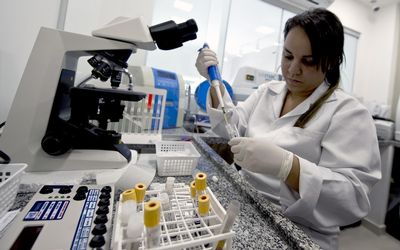IT IS just the start of the US mosquito season, but companies that make insect repellent are already running factories near capacity as they anticipate surging demand in response to the spread of the Zika virus.
Insect repellent makers also are working with government agencies around the world to ease the shipping of insect spray across borders should demand crop up in a place where the chemicals are in short supply.
Executives at consumer-products makers and chemical companies say they expect US demand to be two to three times higher than usual this year. Americans spent $168m on insect repellent last year, according to research firm IBISWorld.
Because there is no Zika vaccine or treatment, insect repellent is one of the few weapons people have to protect themselves from mosquitoes, which are hard to control. Pregnant women are particularly at risk, as the virus has been linked to serious birth defects in children born to infected mothers.
The virus has been reported in Central and South America, the Caribbean and parts of Asia. There have been close to 200 cases in the US, all involving travellers who were infected abroad or instances in which the virus was transmitted sexually by men who travelled
"We’re doing anything you can imagine," said Kelly Semrau, spokeswoman for SC Johnson, the maker of Off and Raid products. "We’ve seen what has happened in Latin America; we are preparing for the eventuality that it will be here."
The company’s Wisconsin factory, which produces 600 cans a minute of Off insect spray, last month added a third shift and was running on weekends, effectively operating constantly. Plants in Argentina, Brazil and Mexico also have added shifts, along with five factories in other regions that are running at or near capacity. SC Johnson makes pest control products at 21 of its 25 global factories.
Zika is primarily spread by a mosquito, Aedes aegypti, with a range that runs along the southeastern US from South Carolina to Florida and Texas and Hawaii and some parts of Arizona. It can also be spread by another mosquito, Aedes albopictus, that reaches further north, to New York and Illinois.
In hottest demand are repellents that contain the chemical DEET, which the Centers for Disease Control and Prevention (CDC) says offers good protection against mosquito bites, along with other substances such as picaridin. The CDC recommends repellents with a DEET concentration of 20% or more, as higher concentrations up to 50% provide longer-lasting protection. The CDC says DEET is safe for use by pregnant women when used as directed.
Sales of popular insect-control brands have surged this year, with sales of several products up 100% to 200% in February, according to IRI, a Chicago-based market research firm. Spectrum Brands Holdings, maker of Cutter and Repel brand products, has increased its US insect repellent forecast several times since news of Zika broke last year, said Eric Kenney, the company’s vice-president of home and garden marketing. He said shipments to retailers are three times what they would normally be this time of year
Chemical maker Vertellus Specialties is running three shifts at a North Carolina factory that produces DEET, among other products, and has begun producing the chemical at other plants with flexible product lines.
Vertellus, which has clients throughout the Americas, Europe and Asia, is planning for demand to be twice the normal level and is prepared to handle a surge of that magnitude, said President Jeremy Steinfink.
"If demand were to increase five or 10 times of what’s currently anticipated, additional capacity would take some time to implement," he said. "There will be more demand. The question that is unclear is, ‘At what level will it last?’"
Producers are taking their cues from retailers, who are ordering repellent earlier and in larger quantities than usual. Target, for instance, plans to put insect spray centre stage in its spring lawn-and-garden displays, a spokeswoman said.
Demand is strong in the south and in big cities that are home to many people travelling to South America and the Caribbean. But it is also up in northern markets, where mosquitoes aren’t yet out, she said.
Along with the production ramp-up, repellent makers are in talks with government regulators about ways to make it easier to transport their products across international borders, according to Ms Semrau, the SC Johnson spokeswoman. Repellents, which are considered pesticides, require regulatory approval before they can be imported into most countries, she said.
The US Environmental Protection Agency is expediting the approval process for alternative pesticides should the supply of already approved products run short, an agency spokesman said.
The CDC said it received 193 reports of Zika cases in the US as of March 9. Another 174 cases had been reported in Puerto Rico, where the virus was spreading rapidly, the US Virgin Islands and American Samoa.
Health officials say 80% of people infected with Zika virus do not get sick. Those who do generally develop only mild symptoms. But large numbers of cases of birth defects in Brazil believed to be tied to the virus prompted the CDC to advise pregnant women to avoid travel to areas where Zika is circulating.
More Africa news from The Wall Street Journal
More news from The Wall Street Journal
Premium access to WSJ.com: $1 a week for 12 weeks

A technician analyses blood samples. The clinic in Rio de Janeiro searches for dengue, Zika and chicungunya viruses in blood, a process that takes 30 minutes. Picture: AFP PHOTO/VANDERLEI ALMEIDA
IT IS just the start of the US mosquito season, but companies that make insect repellent are already running factories near capacity as they anticipate surging demand in response to the spread of the Zika virus.
Insect repellent makers also are working with government agencies around the world to ease the shipping of insect spray across borders should demand crop up in a place where the chemicals are in short supply.
Executives at consumer-products makers and chemical companies say they expect US demand to be two to three times higher than usual this year. Americans spent $168m on insect repellent last year, according to research firm IBISWorld.
Because there is no Zika vaccine or treatment, insect repellent is one of the few weapons people have to protect themselves from mosquitoes, which are hard to control. Pregnant women are particularly at risk, as the virus has been linked to serious birth defects in children born to infected mothers.
The virus has been reported in Central and South America, the Caribbean and parts of Asia. There have been close to 200 cases in the US, all involving travellers who were infected abroad or instances in which the virus was transmitted sexually by men who travelled
"We’re doing anything you can imagine," said Kelly Semrau, spokeswoman for SC Johnson, the maker of Off and Raid products. "We’ve seen what has happened in Latin America; we are preparing for the eventuality that it will be here."
The company’s Wisconsin factory, which produces 600 cans a minute of Off insect spray, last month added a third shift and was running on weekends, effectively operating constantly. Plants in Argentina, Brazil and Mexico also have added shifts, along with five factories in other regions that are running at or near capacity. SC Johnson makes pest control products at 21 of its 25 global factories.
Zika is primarily spread by a mosquito, Aedes aegypti, with a range that runs along the southeastern US from South Carolina to Florida and Texas and Hawaii and some parts of Arizona. It can also be spread by another mosquito, Aedes albopictus, that reaches further north, to New York and Illinois.
In hottest demand are repellents that contain the chemical DEET, which the Centers for Disease Control and Prevention (CDC) says offers good protection against mosquito bites, along with other substances such as picaridin. The CDC recommends repellents with a DEET concentration of 20% or more, as higher concentrations up to 50% provide longer-lasting protection. The CDC says DEET is safe for use by pregnant women when used as directed.
Sales of popular insect-control brands have surged this year, with sales of several products up 100% to 200% in February, according to IRI, a Chicago-based market research firm. Spectrum Brands Holdings, maker of Cutter and Repel brand products, has increased its US insect repellent forecast several times since news of Zika broke last year, said Eric Kenney, the company’s vice-president of home and garden marketing. He said shipments to retailers are three times what they would normally be this time of year
Chemical maker Vertellus Specialties is running three shifts at a North Carolina factory that produces DEET, among other products, and has begun producing the chemical at other plants with flexible product lines.
Vertellus, which has clients throughout the Americas, Europe and Asia, is planning for demand to be twice the normal level and is prepared to handle a surge of that magnitude, said President Jeremy Steinfink.
"If demand were to increase five or 10 times of what’s currently anticipated, additional capacity would take some time to implement," he said. "There will be more demand. The question that is unclear is, ‘At what level will it last?’"
Producers are taking their cues from retailers, who are ordering repellent earlier and in larger quantities than usual. Target, for instance, plans to put insect spray centre stage in its spring lawn-and-garden displays, a spokeswoman said.
Demand is strong in the south and in big cities that are home to many people travelling to South America and the Caribbean. But it is also up in northern markets, where mosquitoes aren’t yet out, she said.
Along with the production ramp-up, repellent makers are in talks with government regulators about ways to make it easier to transport their products across international borders, according to Ms Semrau, the SC Johnson spokeswoman. Repellents, which are considered pesticides, require regulatory approval before they can be imported into most countries, she said.
The US Environmental Protection Agency is expediting the approval process for alternative pesticides should the supply of already approved products run short, an agency spokesman said.
The CDC said it received 193 reports of Zika cases in the US as of March 9. Another 174 cases had been reported in Puerto Rico, where the virus was spreading rapidly, the US Virgin Islands and American Samoa.
Health officials say 80% of people infected with Zika virus do not get sick. Those who do generally develop only mild symptoms. But large numbers of cases of birth defects in Brazil believed to be tied to the virus prompted the CDC to advise pregnant women to avoid travel to areas where Zika is circulating.
More Africa news from The Wall Street Journal
More news from The Wall Street Journal
Premium access to WSJ.com: $1 a week for 12 weeks




















Change: 1.19%
Change: 1.36%
Change: 2.19%
Change: 1.49%
Change: -0.77%
Data supplied by Profile Data
Change: -0.08%
Change: 0.12%
Change: 1.19%
Change: 0.00%
Change: 0.10%
Data supplied by Profile Data
Change: 0.30%
Change: 0.31%
Change: 0.40%
Change: 0.30%
Change: 0.46%
Data supplied by Profile Data
Change: 0.14%
Change: -0.31%
Change: -0.13%
Change: -0.33%
Change: 0.22%
Data supplied by Profile Data